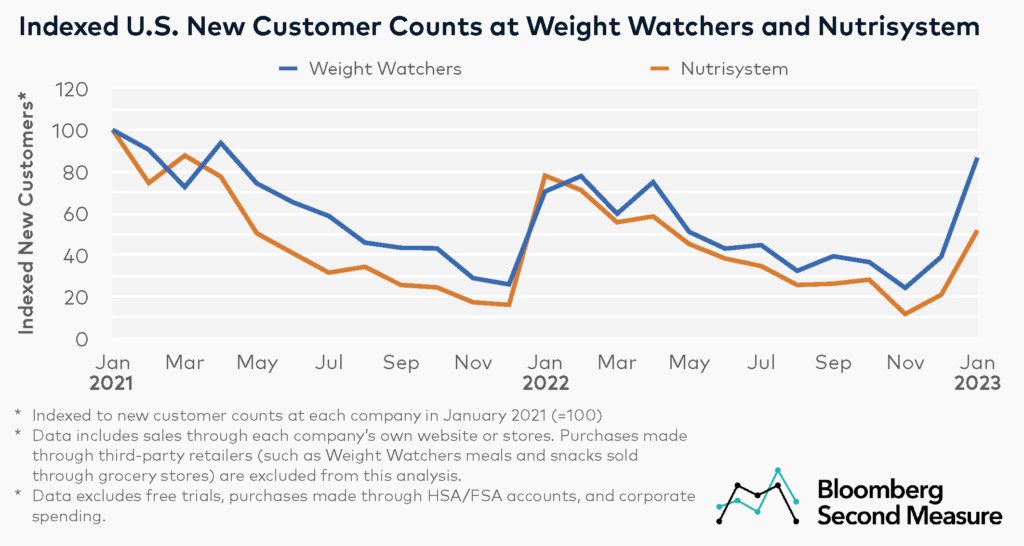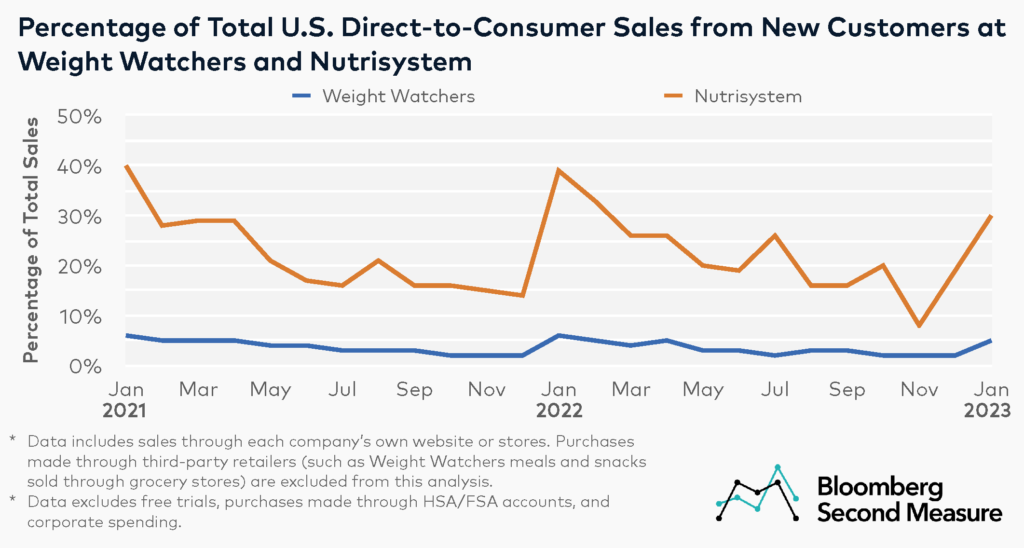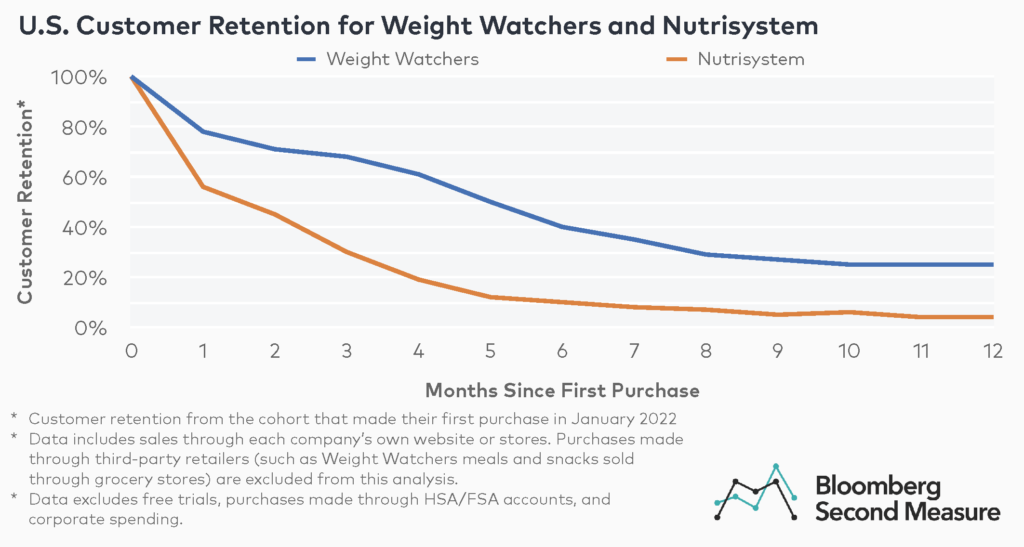Eating healthier food and losing weight are popular New Year’s resolutions. Many U.S. consumers sign up with weight-loss programs to aid in their goal, but how likely are they to stick with their new eating habits? Consumer transaction data shows that weight-loss programs like Weight Watchers—owned by WW International, Inc (NASDAQ: WW)—and Nutrisystem see an uptick in new customers each January. However, retention rates show that most customers who signed up in January 2022 did not remain with either of these programs after a year.
Customer acquisition at WW International (NASDAQ: WW) and Nutrisystem is generally highest in the early months of each year
Looking at customer acquisition patterns over the past two years, Weight Watchers and Nutrisystem saw a spike in new customer counts in the beginning months of the year. New customer counts generally declined throughout the rest of the year, though each company also saw smaller upticks in early spring—perhaps in part due to various discounts and promotions that launched around that time.

In January 2023, Weight Watchers’ customer acquisition was 23 percent higher year-over-year, but 13 percent lower than in January 2021. Nutrisystem’s customer acquisition in January 2023 declined 34 percent compared to January 2022 and 48 percent compared to January 2021.
The two companies offer different approaches to weight loss. Weight Watchers offers a monthly membership that provides nutrition guidance and access to coaching for some plans, in addition to a la carte food items sold through its own website and participating retailers. Nutrisystem, on the other hand, ships pre-portioned meals to its subscribers every four to six weeks.
Notably, Bloomberg Second Measure data includes paid subscribers and excludes customers who sign up for free trials or free subscriptions. Our data also only includes direct-to-consumer (DTC) transactions. Purchases made through third-party retailers (such as Weight Watchers meals and snacks sold through grocery stores) are excluded from this analysis, as are transactions made through HSA/FSA accounts or corporate spending.
Compared to Weight Watchers, Nutrisystem sees a higher percentage of its sales come from new customers
Digging into the sales impact of customer acquisition at Nutrisystem and Weight Watchers, consumer transaction data shows that a higher percentage of Nutrisystem’s sales came from new customers over the past two years, compared to Weight Watchers. Our data also shows that new customers at Nutrisystem spent more on average each month compared to returning customers, while returning customers at Weight Watchers paid slightly more on average most months than new customers. In January 2023, new customers accounted for 30 percent of DTC sales at Nutrisystem. At Weight Watchers, that percentage was 5 percent.

Looking at the sales breakdown in 2022, both companies also saw a higher percentage of their total direct-to-consumer sales come from new customers in January, compared to the rest of the year. In 2022, the average monthly percentage of DTC sales originating from new customers was 3 percent at Weight Watchers, compared to 6 percent in January 2022. Nutrisystem’s average monthly percentage of DTC sales originating from new customers in 2022 was 22 percent, compared to 39 percent in January of that year.
Weight Watchers’ customer retention exceeded Nutrisystem’s among customers who started in January 2022
Nutrisystem and Weight Watchers’ customer retention rates show that many customers lose their appetite for weight-loss programs as the months go on. Among customers who made their first purchase at Weight Watchers in January 2022, 78 percent made an additional purchase the following month. Weight Watchers’ customer retention for this cohort was 40 percent after six months and 25 percent after 12 months.

Similar to meal kit companies that sell pre-packaged ingredients and food items, long-term customer retention is a challenge for Nutrisystem. For the customer cohort that made its first purchase in January 2022, Nutrisystem’s customer retention after one month was 56 percent. Ten percent of this cohort was retained after six months, and 4 percent made an additional purchase at Nutrisystem after 12 months.
Aside from differing business models (Weight Watchers follows a subscription model that offers nutritional advice, while Nutrisystem’s core offering is pre-packaged meals), a potential factor that could affect these observed customer retention rates at Weight Watchers and Nutrisystem is the billing frequency. Customers who prepay for several months at a time will not be captured as retained customers for each of those months.
Bloomberg Second Measure launched a new and exclusive transaction dataset in July 2022. Our data continues to be broadly representative of U.S. consumers. As a result of this panel change, however, we recommend using only the latest post in assessing metrics, and do not support referring to historical blog posts to infer period-over-period comparisons.
